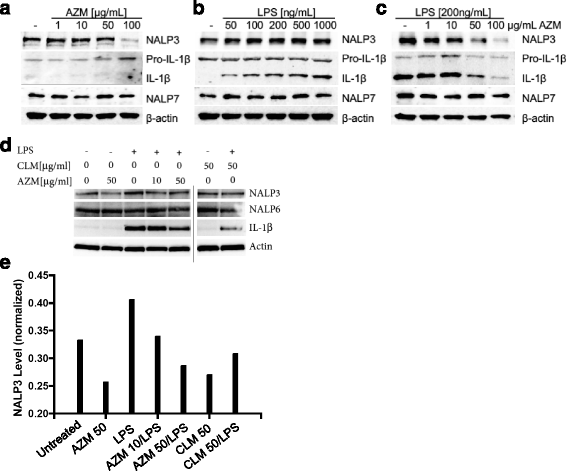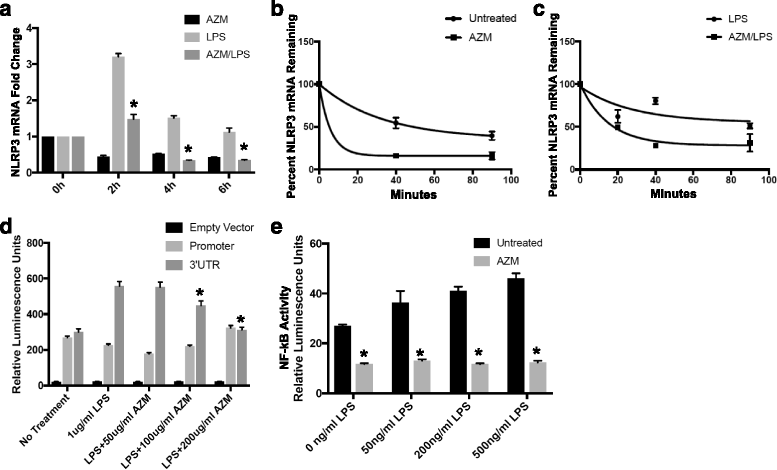Azithromycin decreases NALP3 mRNA stability in monocytes to limit inflammasome-dependent inflammation
- PMID: 28659178
- PMCID: PMC5490165
- DOI: 10.1186/s12931-017-0608-8
Azithromycin decreases NALP3 mRNA stability in monocytes to limit inflammasome-dependent inflammation
Abstract
Background: Azithromycin, an antibiotic used for multiple infectious disorders, exhibits anti-inflammatory effects, but the molecular basis for this activity is not well characterized. Azithromycin inhibits IL-1β-mediated inflammation that is dependent, in part, on inflammasome activity. Here, we investigated the effects of azithromycin on the NACHT, LRR, and PYD domains-containing protein 3 (NALP3) protein, which is the sensing component of the NALP3 inflammasome, in human monocytes.
Methods: THP-1 cells were treated with azithromycin alone, LPS alone, or both. NALP3 and IL-1β protein levels were determined by immunoblotting. NLRP3 gene (encoding NALP3) transcript levels were determined by quantitative qPCR. In order to measure NLRP3 transcript decay, actinomycin D was used to impair gene transcription. THP-1 Lucia cells which contain an NF-κB responsive luciferase element were used to assess NF-κB activity in response to azithromycin, LPS, and azithromycin/LPS by measuring luminescence. To confirm azithromycin's effects on NLRP3 mRNA and promoter activity conclusively, HEK cells were lipofected with luciferase reporter constructs harboring either the 5' untranslated region (UTR) of the NLRP3 gene which included the promoter, the 3' UTR of the gene, or an empty plasmid prior to treatment with azithromycin and/or LPS, and luminescence was measured.
Results: Azithromycin decreased IL-1β levels and reduced NALP3 protein levels in LPS-stimulated THP-1 monocytes through a mechanism involving decreased mRNA stability of the NALP3 - coding NLRP3 gene transcript as well as by decreasing NF-κB activity. Azithromycin accelerated NLRP3 transcript decay confirmed by mRNA stability and 3'UTR luciferase reporter assays, and yet the antibiotic had no effect on NLRP3 promoter activity in cells containing a 5' UTR reporter.
Conclusions: These studies provide a unique mechanism whereby azithromycin exerts immunomodulatory actions in monocytes by destabilizing mRNA levels for a key inflammasome component, NALP3, leading to decreased IL-1β-mediated inflammation.
Figures



Similar articles
-
Fluorofenidone attenuates pulmonary inflammation and fibrosis via inhibiting the activation of NALP3 inflammasome and IL-1β/IL-1R1/MyD88/NF-κB pathway.J Cell Mol Med. 2016 Nov;20(11):2064-2077. doi: 10.1111/jcmm.12898. Epub 2016 Jun 16. J Cell Mol Med. 2016. PMID: 27306439 Free PMC article.
-
Atrial natriuretic peptide down-regulates LPS/ATP-mediated IL-1β release by inhibiting NF-kB, NLRP3 inflammasome and caspase-1 activation in THP-1 cells.Immunol Res. 2016 Feb;64(1):303-12. doi: 10.1007/s12026-015-8751-0. Immunol Res. 2016. PMID: 26616294
-
Atorvastatin suppresses NLRP3 inflammasome activation via TLR4/MyD88/NF-κB signaling in PMA-stimulated THP-1 monocytes.Biomed Pharmacother. 2016 Aug;82:167-72. doi: 10.1016/j.biopha.2016.04.043. Epub 2016 May 9. Biomed Pharmacother. 2016. PMID: 27470352
-
Interleukin-1 and the Inflammasome as Therapeutic Targets in Cardiovascular Disease.Circ Res. 2020 Apr 24;126(9):1260-1280. doi: 10.1161/CIRCRESAHA.120.315937. Epub 2020 Apr 23. Circ Res. 2020. PMID: 32324502 Free PMC article. Review.
-
Curcumin: an inflammasome silencer.Pharmacol Res. 2020 Sep;159:104921. doi: 10.1016/j.phrs.2020.104921. Epub 2020 May 25. Pharmacol Res. 2020. PMID: 32464325 Review.
Cited by
-
Mycobacterium abscessus Clearance by Neutrophils Is Independent of Autophagy.Infect Immun. 2020 Jul 21;88(8):e00024-20. doi: 10.1128/IAI.00024-20. Print 2020 Jul 21. Infect Immun. 2020. PMID: 32423916 Free PMC article.
-
Pediatric Acute-Onset Neuropsychiatric Syndrome: Current Perspectives.Neuropsychiatr Dis Treat. 2023 May 24;19:1221-1250. doi: 10.2147/NDT.S362202. eCollection 2023. Neuropsychiatr Dis Treat. 2023. PMID: 37251418 Free PMC article. Review.
-
Membrane inflammasome activation by choriodecidual Ureaplasma parvum infection without intra-amniotic infection in a Non-Human Primate model†.Biol Reprod. 2024 May 9;110(5):971-984. doi: 10.1093/biolre/ioae027. Biol Reprod. 2024. PMID: 38335245 Free PMC article.
-
Preventing the development of severe COVID-19 by modifying immunothrombosis.Life Sci. 2021 Jan 1;264:118617. doi: 10.1016/j.lfs.2020.118617. Epub 2020 Oct 20. Life Sci. 2021. PMID: 33096114 Free PMC article. Review.
-
Immunomodulation to Prevent or Treat Neonatal Sepsis: Past, Present, and Future.Front Pediatr. 2018 Jul 19;6:199. doi: 10.3389/fped.2018.00199. eCollection 2018. Front Pediatr. 2018. PMID: 30073156 Free PMC article. Review.
References
-
- Albert RK, Connett J, Bailey WC, Casaburi R, Cooper JA, Jr, Criner GJ, Curtis JL, Dransfield MT, Han MK, Lazarus SC, Make B, Marchetti N, Martinez FJ, Madinger NE, McEvoy C, Niewoehner DE, Porsasz J, Price CS, Reilly J, Scanlon PD, Sciurba FC, Scharf SM, Washko GR, Woodruff PG, Anthonisen NR, C. C. R. Network Azithromycin for prevention of exacerbations of COPD. N Engl J Med. 2011;365:689–698. doi: 10.1056/NEJMoa1104623. - DOI - PMC - PubMed
-
- Saiman L, Marshall BC, Mayer-Hamblett N, Burns JL, Quittner AL, Cibene DA, Coquillette S, Fieberg AY, Accurso FJ, Campbell PW, 3rd, Macrolide Study Group et al. Azithromycin in patients with cystic fibrosis chronically infected with Pseudomonas aeruginosa: a randomized controlled trial. JAMA. 2003;290:1749–1756. doi: 10.1001/jama.290.13.1749. - DOI - PubMed
Publication types
MeSH terms
Substances
Grants and funding
LinkOut - more resources
Full Text Sources
Other Literature Sources
Miscellaneous

